Hands-Free Home Automation with Control4
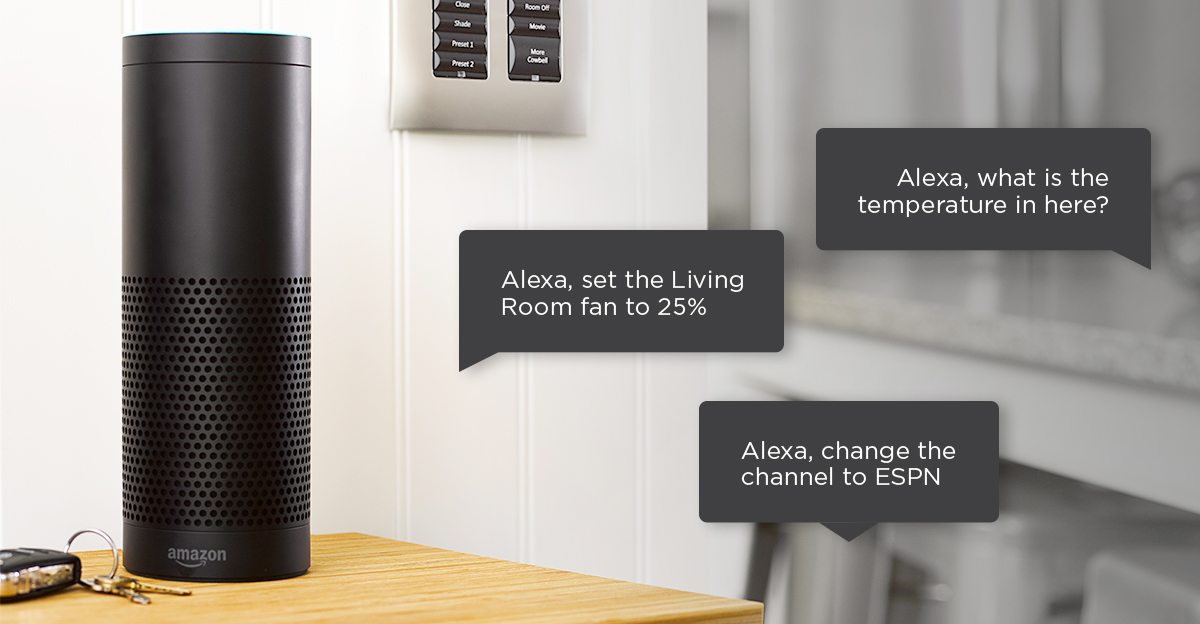
If you’re already living in a Control4 Smart Home, you know how simple it is to set the mood with a single touch of a button. And with the Control4 Smart Home Skill for the Amazon Alexa family of devices, it’s even easier to control your smart home with just your voice and a few simple commands.
At Control4, we are proud to deliver true whole-home automation with devices that actually work in concert. “Scenes”, as we call them, orchestrate multiple devices at once to help make life in your home more convenient and enjoyable. And with the updated skill for Alexa, we’re putting more smart home power at the tip of your tongue.
The possibilities are up to your imagination. But here are some of our customers’ favorite scenes and how they can be controlled using just your voice.
(Note: initial scenes must be set up by a Control4 smart home professional first.)
- As you walk in the door, ask Alexa to turn on your “Welcome” scene, and your house invites you home with lights that lead the way while the family room TV fires up your favorite channel.
- Simply say “Alexa, turn on ‘Cooking’” and the kitchen fixtures ramp up to provide more light—from the pendants to the pantry — while Spotify turns on your favorite playlist, completely hands-free.
- From the comfort of your own bed, ask Alexa to put the house to sleep. Instantly, all lights turn off, shades close, doors lock, and the security system is armed. Simply say “Alexa, turn off house.”
Of course, sometimes you’ll want to control individual devices as well:
- “Alexa, turn on/off the dining chandelier”
- “Alexa, dim master bedroom lamp to 40%”
- “Alexa, adjust the thermostat to 70 degrees”
- “Alexa, lock the front door”
- “Alexa, what is the temperature in here?”
- “Alexa, set the Living Room fan to 25%”
- “Alexa, turn on the Apple TV”
- “Alexa, change the channel to ESPN”
- “Alexa, pause the Blu-ray player”
Right out of the box, Control4 homeowners will have the ability to use voice control for the devices and scenes they already have set up on their system, without the need for any new programming. This includes; smart door locks, ceiling fans, lights, thermostats, and entertainment devices. Simply add the Control4 Smart Home Skill in the Amazon Alexa App, authenticate with Control4, discover devices, and you’re on your way. You can find the easy to follow, step-by-step video instructions on our Control4 Alexa page or get instructions on the customer portal.
Should you require more complex programming or want to extend your automation capabilities, an All Star Audio Video smart home professional can assist you.
Add Magic to Your Home Theater Movies
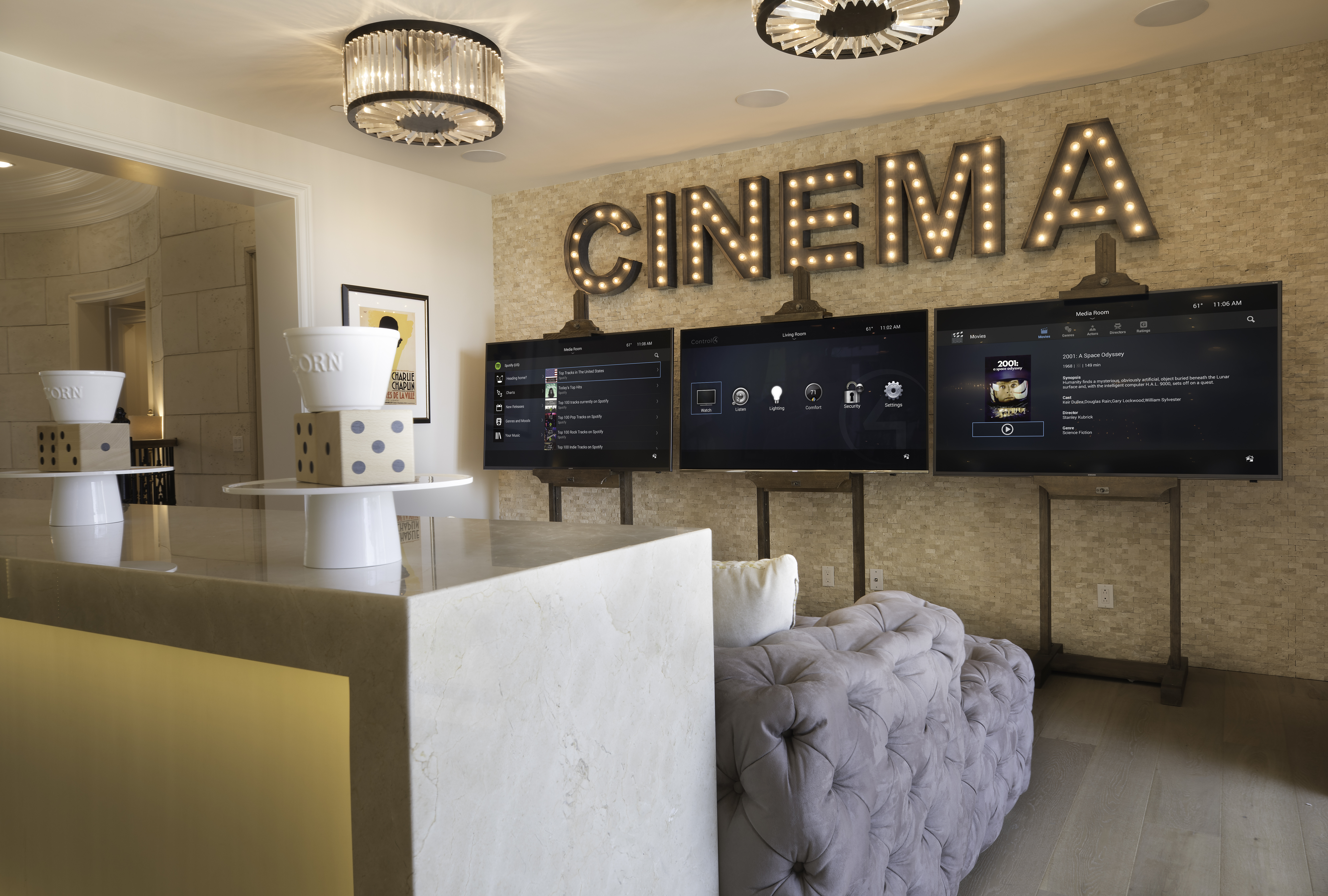

TIPS TO CREATE A STRIKING CINEMA AT HOME
Since the earliest days of cinema, moving picture shows have provided a refuge from the reality of ordinary life. There’s something undeniably special about sitting back and seeing the room fall into darkness as voices lower to a whisper and the credits begin to roll.
The mystery behind the movie magic will always be a part of its charm. But the rules for replicating this experience yourself don’t have to be such a secret. Today, armed with the latest technology and a little DIY ingenuity, you can bring Hollywood to life for much less than you might have imagined.
STARTING NEW OR STARTING OVER?
If you can start new from scratch and include blueprints for a theater in the initial construction, you’re already one step ahead. Collaborate with your building contractor and create a custom-purpose room that fits seamlessly with the style, character, and function of the rest of your property. When building your theater from the bottom up, you can plan ahead to include the wiring you’ll need for lighting, audio, and video before the walls are even built. And if you’d like to mount a retractable projector, install professional-quality cinema seats, or add extra sound-absorbing insulation. These features can be better accommodated early on, as well.
Most experts would agree that the basement is the best area of the home in which to replicate the traditional theater experience. This is because, for optimal sound and video, a dedicated media room should be as isolated as possible—think thick concrete walls, few doors and windows, and just enough room to seat everyone comfortably. Your space should be constructed with acoustics in mind and to the ideal dimensions for viewing.
Starting over with a retrofit of an existing garage, attic, or side room, however, will require a bit more creativity.
You might think that the technological equipment you buy and furniture you put in the space will define your theater experience. This, however, is not the case. Making an effort to optimize your room’s existing physical acoustical characteristics will go the furthest toward creating a truly immersive environment, and it begins with understanding the shape of your room and the dimensions you’re working with. Bigger rooms mean deeper base, and that’s never a bad thing. But smaller spaces make it easier to create an intimate, sealed-in soundscape.
To begin, look carefully at the room you’ve chosen to remake into a theater. When creating the perfect home system, you’ll want to plan out ahead of time how to maximize every inch you have to work with. The placement of windows, walls, and other furnishings will significantly impact the acoustics and operation of every component you choose to install. Draw up plans to help avoid any construction challenges before you begin tearing down (and into) your walls. Confirm that your room has the space to accommodate a 100- to 120-inch screen, and the throw distance to match your projector to that screen. And, of course, you’ll want to make sure that the space can become completely dark when it’s time for the movie to begin.
Last but not least, it’s wise to “future proof” your system and design it in such a way that makes it easy to upgrade components down the road. By introducing two-inch cable conduit into the pre-wire planning phase, you can help future cables, like fiber optic, fit through finished ceilings and walls without effort.
Now if you’re at the design stage, but aren’t sure what technology you need to include in your new home theater system, know that this year most products are “smarter” than ever before. There’s plenty of new audio/video equipment and theater trends that hit it big in 2017. Here are some suggestions to start your shopping list:
Selecting the right electronic equipment will elevate your movie-watching experience and help you replicate all the timeless romance, drama, and mayhem of the silver screen. You don’t need to spend a fortune outfitting your room with the latest and greatest components; you just need to spend wisely. And don’t forget your tape measure—whatever equipment you buy, you’ll need it to fit through the door!
Audio
Start from the sound up. Make sure to budget for all acoustical components you’ll need to ensure a three-dimensional audio experience. You don’t have to be an audiophile to appreciate the value of a strong sound system. When it comes down to it, the most important aspect of a film is the dialogue. Every cent spent on a surround sound speaker system will be well worth it!
Depending on how you’ve chosen to design your theater room, you may have room to add more speakers and possibly more than one subwoofer. But for a “traditional” Dolby Digital 5.1 system, you’ll need five speakers (front and center channel speakers, plus left and right surround speakers) and one decent sub. The placement of the subwoofer and the speakers in your room will have a significant impact on sound quality and bass, so give yourself enough room to move everything around a bit. A longer cable (25 ft. / 7.62 meters or so) will help here, and for speaker wire, a 250-ft. (76.2 meters) roll of 16-gauge wire should do the trick. Ideally, your left and right front speakers should be placed at an identical angle away from the central seating point, equidistant from both the audience and the screen. Allow a clear path for the sound to travel; if you can’t see one or both of them, sound is being blocked. Place your surround speakers on both sides of the seating area just above ear height. The location of the subwoofer is the most flexible—just be sure to avoid placing it directly in a corner. Don’t be afraid to fine-tune its placement as you begin putting your theater system to use.
Visuals
There’s nothing like sitting in the glow of a crystal-clear movie image, and with little more than a pitch-dark room, a projector, and a screen, you’ll be able to achieve a fairly adequate visual presentation. But with today’s technology moving at breakneck speed, there’s no reason to not look for devices that deliver the best and brightest in modern movie viewing. Some of the newest models will even let you go 3D.
A projector and a large screen will allow you to go big, but before you plunk down the cash for a new projector, be sure to calculate exactly what’s best for your room. It’s wise to go online and choose a model that offers a winning combination of picture quality, light output, and price. And while a great projector may come at a steep cost up front, it will give you and your audience the best possible box office experience.
Now, when it comes to the projection screen, you essentially have two options: fixed and retractable. A fixed screen is the superior choice for several reasons. First, a fixed screen with a frame border (ideally covered in soft, black material) will help everyone’s eyes focus on the bright moving pictures and amp up the perceived contrast of the image.
Your audio/video receiver might not be the hottest piece of equipment, but it’s the hub of your home theater—the brains of the operation. Your amplifier and receiver will tell your sound system what to do and how to sync up with what’s on screen. Today’s selection of home theater receivers offers all the fundamentals: 5.1 surround sound support, 3D compatibility, and more user-friendly functionality.
Lighting is the last critical component. Control4’s smart lighting line will raise your home theater’s IQ by providing wireless dimmer, switch, and keypad functionality. Gone are the days of getting up to switch lights on and off after the movie has started. A connected light system will allow you to not only control the color and brightness of the bulbs, but also switch up the room’s ambiance right from your remote or the smartphone in your pocket.
Extra Accessories
An expansive theater setup often leads to a tangled mess of wires, but this can be avoided with some simple cable clamps and ties, a cord organizer, and cable tunnel kit. Be sure to purchase a power protection device as well; in case of a sudden electrical spike or a power outage, you’ll want to be prepared.
SEATING, FLOORING, AND MORE
If you’re going to invest in quality audio/video equipment, it only makes sense that you’ll also want to customize the room’s flooring, seating, and decor for acoustical balance and ease of viewing. A perfect theater experience encompasses all five of the viewer’s senses: sight, sound, touch, taste, and even smell. From comfy theater seats to freshly popped popcorn, why shouldn’t you have it all?
First, make sure your room’s flooring treatment will be an asset to your new sound system. Carpeted floors are best for absorbing big, powerful bass, as well as for helping to control and clarify higher frequencies. And in your dedicated theater room—as we’ve mentioned before—it’s critical to have total control over ambient light. Any glimpse of the sun risks washing out the image on screen. You have a wide range of options when it comes to sound and light proofing your space. Thick drapes work double duty by working as sound absorbers as well as sealing out sunshine. And for the ceiling, soundproofing acoustic deadening sound tiles are an inexpensive way to minimize as much outside noise as possible.
Now you can consider different seating possibilities. Shipping pallets are a terrific and inexpensive option, but you’ll need space to set them up the right way. Once they’re in place, however, you can fit DVDs, books, and magazines into spaces on the side for additional storage. If you’ve got a bit more room in your budget, you can look beyond DIY seats and max out on lounge recliners, typically with cup holders, foot rests, massagers, and heat all built in. Bottom line is, while there are a few constraints in how you plan your seating style, don’t be afraid to follow stereotypical conventions. Bean bag chairs, even inflatable couches, are making a comeback. Just be sure that any type of unconventional seating you add won’t negatively impact the room’s acoustics or block anyone’s view!
In a dedicated home theater space, you can go as wild as you like with the decor (Lava lamps? Shag rugs? A cheeky life-sized replica of the Gojira monster?), but if your guests don’t share a passion for retro 60’s ambiance (or anything else your humble heart desires to hang on the wall), be sure to have another secret weapon at the ready: salty, sugary, irresistible movie snacks. Any truly epic home cinema will provide the audience with delicious concessions to accompany whatever’s screening that night, whether it be a film club viewing of Citizen Kane or the debut of a new Minions flick. For this, use a little imaginative effort to assemble a snack bar that can hold your preference of food and beverages. True connoisseurs should consider a margarita machine, a home soda fountain, or even a beer tap.
VIDEO DISTRIBUTION
Finally, you’re ready to sit down with a cold soda, your favorite film treat, and enjoy the show. When your home theater system is “smart” enough to connect to a myriad of other products in your home (such as the shades, security system, and door locks), you can put your mind at ease and lose yourself in the moment at hand. A single tap on a Control4 touch screen can start or stop the movie in an instant, if needed, and connect you to other audio and video devices around the home.
And wouldn’t it be even more convenient if you could experience the pleasure of your audio and video media in every room? With Control4’s multi-room video solutions, every member of your home audience is able to enjoy the same film you’re watching in any room of the house. Using one remote, you can distribute 10 HDMI sources (satellite/cable boxes, streaming media, media players, or gaming devices) to 10 video display locations in crisp, clear 4K HD.
An unbeatable home theater is within reach, and the latest technology can provide for intelligent solutions for both new construction homes or retrofit installs. Armed with a little research and simple DIY skills, you too can create a killer home theater in less than the total run time of Gone with the Wind.
GoldenEar Triton Reference Speaker Review

 Where do you go after you’ve created one of the most critically acclaimed speakers of the past decade, if not longer? I’m referring, in case it needs spelling out, to GoldenEar Technology’s Triton One, a speaker that garnered the sort of ink in the year of its release that’s normally reserved for new surround sound formats or video standards in the AV press. And deservedly so. It positively redefined the level of performance achievable from a $2,500 speaker.
Where do you go after you’ve created one of the most critically acclaimed speakers of the past decade, if not longer? I’m referring, in case it needs spelling out, to GoldenEar Technology’s Triton One, a speaker that garnered the sort of ink in the year of its release that’s normally reserved for new surround sound formats or video standards in the AV press. And deservedly so. It positively redefined the level of performance achievable from a $2,500 speaker.
But back to my original question: where do you go from there? For GoldenEar, the answer to that question, for the past few years at least, has involved filling out and revamping the rest of its lineup, with highly lauded new passive speakers, a new XXL center speaker to keep up with the sound and fury of the Triton One, an entirely new subwoofer line, and some substantial tweaking to the second- and third-largest speakers in the Triton tower lineup to bring them more in line with the performance of the Triton One.
So, what’s next for the company? Somewhat surprisingly, a bigger, better, badder flagship speaker that ups the ante on size, design, and performance. With no integers lower than One to rely on, GoldenEar has dubbed it the Triton Reference ($4,250 each). Although it seems at first blush to be a Triton One on steroids, this new beast is pretty much an entirely new creation from bottom to top.
Starting at the bottom, each Triton Reference tower features a quartet of 10.5- x 9.5-inch side-mounted infrasonic radiators, similar to the ones found at the top and bottom of the company’s SuperSub X subwoofer, but tweaked for even higher excursion. Next up, a trio of newly designed 6- x 10-inch active bass drivers, with 40 percent more surface area than the active bass drivers found in the Triton One and a newly designed “Focused Field” magnet structure that also drives its pair of 6-inch Multi-Vaned Phase Plug cast-basket mid/bass drivers.
 Last but certainly not least, the Triton Reference features an entirely new version of the driver that could be considered GoldenEar’s secret sauce. Its Reference HVFR (high-velocity folded ribbon) tweeter incorporates 50 percent more neodymium as the company’s other offerings, and it promises both improved transient response and higher efficiency.
Last but certainly not least, the Triton Reference features an entirely new version of the driver that could be considered GoldenEar’s secret sauce. Its Reference HVFR (high-velocity folded ribbon) tweeter incorporates 50 percent more neodymium as the company’s other offerings, and it promises both improved transient response and higher efficiency.
The drivers alone tell only part of the story, though. Venture inside the speaker, and you’ll find new wiring, a reprogrammed 56-bit DSP control unit, a further tweaked crossover network, a proprietary blend of long fiber lamb’s wool and poly-fiber for internal damping, and a 2.4mm-thick steel plate built into the base for increased rigidity.
Perhaps most noteworthy, at least from a visual standpoint, is the speaker’s new one-piece monocoque cabinet with a hand-rubbed piano gloss-black lacquer finish. The speaker still strikes a pose that is decidedly GoldenEar, but the sleek glossy finish gives the speaker an air of aesthetic luxury that its forebears have never quite been able to claim. My wife (long a fan of the GoldenEar sound but never smitten with their looks) exclaimed upon seeing prototype renderings of the Triton Reference: “Wait! Is that the same company that normally makes the big black socks?”

Indeed it is. The new look makes sense for the Triton Reference for a number of reasons. Firstly, the one-piece black fabric wrap for which GoldenEar is known just barely worked for the massive Triton One. Add four inches in height and roughly an inch in depth, not to mention the extra weight added by a step up from 1,600 to 1,800 watts of amplifier power, and the Triton Reference would be nearly impossible to move without a good solid surface to hold onto. There’s also the issue of price to consider. Value has always been a significant portion of GoldenEar’s appeal, and adding several hundred bucks to the cost of a $4,250 speaker isn’t quite as impactful as would be the same cost added to a $2,500 or $1,250 one.
Whatever the reasoning and justification for the new design, it’s hard to deny its appeal. For the first time, in my opinion, GoldenEar Technology has unveiled a speaker whose looks are an undeniable match for its performance. And given its performance, that’s saying a lot.
As is usually the case, I stopped by GoldenEar’s suite the day before CES to say hello and see what was on slate for this year’s show. Unlike previous years, though, I had the opportunity to sit and spend an entire afternoon with the new speakers, listening to a few discs’ worth of my own favorite tunes, alone and without interruption.
Before we dig into any specific impressions, let’s go ahead and get this out of the way from the giddyup: yes, the GoldenEar Triton Reference’s bass is undeniably stellar. Perhaps even more stellar than I was expecting. It stands to reason from reading the specs alone that bass would be improved over the already staggering Triton One. This is, after all, a speaker that’s larger than my 22-year-old daughter by any metric you choose to measure it. What I wasn’t expecting, though, was bass performance that’s so completely and utterly controlled, nimble, and even delicate at times.
One particular example is with Jean Victor Arthur Guillou’s arrangement of Pictures at an Exhibition: I. Gnomus, an organ-heavy piece with notes so deep as to be felt more than heard. It’s a piece I’ve heard a number of times through a number of speakers, and I’ve always found the bass either underwhelming or overwhelming–either nearly non-existent or domineering. Through the Triton Reference speakers, though, it hit that perfect Goldilocks zone: weight, authoritative, but not at all out of proportion with the rest of the mix.
I don’t want to dwell on the bass too much, because there really isn’t much more one could say other than that. It’s practically flawless. But I also popped in Beastie Boys’ “Hey Ladies” and cranked it to the high heavens just for fun, almost in an attempt to push the passive radiators to the burping point. It was a futile attempt. The track thumped and thumped hard, but try as I might, I couldn’t stress the speakers to anything approaching a breaking point.
What impressed me more than that, though, was how the speakers handled one of my favorite Björk tracks, one I rarely listen to over loudspeakers for obvious reasons. “Headphones” is a song that was made for its namesake, especially in the way it plays around with the in- and out-of-head experience. What shocked me most was just how … intimate the song sounded through the Triton Reference speakers. They were set up a good 10 feet away from me, and as far apart, closer to the boundary walls that I would have set them in my own home. And yet the listening effect was, with this song, akin to a pair of really amazing nearfield monitors. My listening notes are full of words like “holographic,” “spooky,” and “frighteningly tangible.”
Joss Stone’s “The Chokin’ Kind” gave me a similar sensation. Not the spookiness, mind you, nor the holographic nature–because the song isn’t mixed that way. But again, words like “intimate” pepper my notes. The speakers capture the breathy detail (and even the mouth noises) of the mix perfectly, seemingly teleporting past the air rather than passing through it, while also delivering the sort of silky smooth, sultry bass that goes straight to your naughty bits.
Another track that blew me away was “Question” by The Moody Blues. The dynamic punch at the beginning of the track and near the end was pure GoldenEar, simply cranked to eleven. But even more impressive to my ears is the way the speakers handled the song’s varying width: the way it shifts back and forth between wall-to-wall width and a narrow, more personal, focused sound during the middle bits. I’m trying hard to think of another speaker I’ve heard capture that element of this song nearly so well. I’m failing. Hard.
Another noteworthy track was “Why We Build the Wall” from Anaïs Mitchell’s folk opera Hadestown. What sets this song apart is that Greg Brown’s vocals (in the role of Hades) are so deep and rich as to demand pretty much equal effort from bass and midrange drivers and tweeter alike. As such, I’ve found that, with larger speakers and especially in systems with subwoofers, his voice can sound a little disconnected from itself. It tends toward being a bit of a triangle–weighty and wide at the bottom and rising to a point in the middle. That’s not the case with the Triton Reference. His voice is a thick, rich, solid rock right in the center of the soundstage, booming out from a definite point in space.
High Points
• GoldenEar’s Triton Reference speakers builds upon the foundation of the company’s previous powered towers, delivering all of the rich and powerful bass, smooth and natural midrange, and penetrating, deliciously detailed high frequencies of previous efforts, with the obvious added benefits of more power, more dynamics, deeper bass, and superior imaging.
• Surprisingly for such a massive speaker, it’s also GoldenEar’s most cohesive effort yet. The line between bass, mids, and treble is imperceptible. Try as I might, I could never get the slightest sense of where the powered bass drivers left off and the passive midrange drivers picked up. Ditto for the transition between the mids and the HVFR tweeters. The disparate drivers work in concert to create the sort of unified listening experience you would expect from massive (like, truly massive) planar magnetic panels.
• Owing to its powered bass section, new crossover design, and exceptional efficiency (93.25 dB, anechoic), the Triton Reference speaker can be driven by pretty much any good amplifier. So, if you’re in to low-powered Class A amps, you’re good to go. If gigantic Class D mono blocks are more your speed, you’re covered there, too. Within reasonable bounds (nothing below, say, 20 watts per channel on the low end and not much more than 750 watts per channel at the extreme), you’d have a hard time finding an amp that doesn’t work with these big, beautiful beasts.
Low Points
• At 58 inches tall and weighing in at 110 pounds apiece, the Triton Reference is a daunting speaker in many respects. It certainly isn’t a loudspeaker that you’ll be unpacking and positioning by yourself. Or, heaven forbid, if it is, then may I never cross you in a dark alley.
• As gorgeous as the new cabinet is (and it’s truly gorgeous in a way that pictures don’t do justice), it’s a shame that piano black is the only finish option. While I understand that GoldenEar’s primary mission is to deliver unparalleled performance at unheard-of price points (mission accomplished there, for sure) and while I also get that adding custom finishes (or even offering multiple finishes) would have jacked up the MSRP substantially, I think it would be worth the extra expense. The thought of seeing these beauties in Shark Gray Metallic or Laguna Blue Tintcoat makes my heart go pitter-patter. But for now, such finish options are only the dream of yours truly.
Comparison and Competition
GoldenEar has entered into new and less populated territory with its Triton Reference tower. As such, finding speakers with which to compare it isn’t easy (nor, in my opinion, incredibly informative). There are a few in this price range that deserve mentioning, though, if budget is your primary concern.
Paradigm’s new Persona 3F (the smallest in its flagship line, measuring just over 44 inches tall) sells for $5,000 each, making it a bit more expensive than the Reference but certainly worth auditioning if you’re shopping for offerings in this ballpark.
MartinLogan’s Impression ESL 11A, at $9,995 per pair, is also in roughly the same price territory (give or take 1,500 bucks), and its massive electrostatic panel should appeal to those who love the clarity and transparency of GoldenEar’s high-velocity folded ribbon tweeter.
The Triton Reference also snuggles quite nicely between the B&W 804 D3 and 805 D3 in price, the former coming in at $9,000 per pair and the latter selling for $6,000.
Perhaps a more apt comparison could be made to speakers a bit off the beaten path, like the active version of ADAM Audio’s Classic Column MK3, which sells for $10,000 per pair. Like the GoldenEars, the active Classic Column MK3 relies on a folded ribbon tweeter, but it also features a larger folded ribbon midrange driver. Its powered version also provides amplification (of the Class AB variety) to all its drivers, not just the bass section. Low-frequency extension is rated at 30 Hz, though, as compared with the Triton Reference’s gut-wrenching 12 Hz.
In terms of the total package–the impact and authority of its bass, combined with the depth of its soundstage and remarkable detail–I’ve never heard a speaker that truly bests the Triton Reference at anything approaching its price.
Conclusion
The phrase “statement piece” is used and misused quite frequently in our industry, often to mean an unrealistic, cost-no-object proof of concept that may or may not make it to market, and is usually only attainable by the one percent if it does. In every meaningful respect, the GoldenEar Triton Reference speaker is a statement piece, but not in that way. Yes, it does deliver the sort of performance previously delivered only by cost-no-object speakers. And yes, if you have room for these speakers in your living room, you’re certainly making a statement.
But as hard as it is for me to describe a $4,250 speaker as an exceptional value and expect to be taken seriously–after all, I know that’s far outside the budget range of many of our readers–when you get down to brass tacks, this truly is, above all else, an incredibly high-value speaker that simply doesn’t sounds like price was considered at all in its design process. If anything, I think it’s underpriced.
The World of 4K Video Has a Bright Future
 4K Ultra HD (UHD) TV has been around for several years now. It was first introduced in the market with somewhat mixed reviews. Everyone raved that the extra image resolution was incredible. While it was to be expected, there were, however, a number of caveats made when it was initially introduced. Most people were concerned because there was very little content available, not to mention the small amount of devices actually produced to playback the limited content. Concerns were also raised regarding the pricing of 4K UHD TV; it was too expensive for most people to even consider. In those early days, not all details and specifications regarding 4K UHD were even agreed upon. Today, however, thanks to new innovations and introductions, 2016 looks to be a knockout year for the 4K UHD TV.
4K Ultra HD (UHD) TV has been around for several years now. It was first introduced in the market with somewhat mixed reviews. Everyone raved that the extra image resolution was incredible. While it was to be expected, there were, however, a number of caveats made when it was initially introduced. Most people were concerned because there was very little content available, not to mention the small amount of devices actually produced to playback the limited content. Concerns were also raised regarding the pricing of 4K UHD TV; it was too expensive for most people to even consider. In those early days, not all details and specifications regarding 4K UHD were even agreed upon. Today, however, thanks to new innovations and introductions, 2016 looks to be a knockout year for the 4K UHD TV.
4K UHD technology, which is also called 2160p UHD TV, is known for its outstanding resolution. There are twice the number of pixels, both horizontal and vertical, as that of the 1080p HDTV. The benefits of ultra-high definition technology can be seen on the larger screen sizes of 4K UHD TVs. Additional improvements in picture quality have come from the new HDR technology (high dynamic range) that is now being added to many 4K UHD TVs and other related components. When HDR is incorporated into 4K UHD TVs, the picture quality is stunning and viewers realize quickly that this new technology reproduces an amazingly wide range of colors with subtle shading details that cannot be seen on a TV that does not include high dynamic range technology. In order for the HDR technology to perform as it should, the original source material must use HDR technology as well. During 2016, consumers will find that the majority of 4K UHD Blu-Ray players and discs will incorporate the new HDR technology. In addition, Netflix and Amazon have plans in the works to provide an assortment of HDR titles this year.
Of course, it will be a while before the amount of 4K UHD content that is available to stream, buy or rent reaches the amount of 1080p HD video that is currently available in the market. The good news is that this is a situation that is changing rapidly and dramatically. Besides Netflix and Amazon increasing their available selection of 4K UHD content, other sources such as Kaleidoscope, UltraFlix, YouTube and Vimeo are continuing to boost their 4k UHD content as well.
While many people were concerned about limited content when 4K Ultra HD hit the market, 4K UHD Blu-ray discs became available early this year. Warner Brothers, Sony Pictures Home Entertainment and 20th Century Fox now offer movies on 4K UHD Blu-Ray discs. Not only do these new discs offer enhanced image resolution, they are also able to take advantage of the latest HDR technology.
If you have been contemplating equipment and content upgrades in your home theater, now is the time to check out the latest 4K video technology. Do your research now, not only checking out 4K UHD TV models, but also related Blu-Ray players, projectors and various service providers. In many cases, the pricing has become much more reasonable, thus it looks like this could be your year to make the switch to 4K UHD technology!
GoldenEar’s Top-of-the-Line Triton One
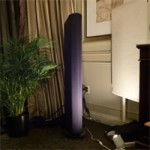 The GoldenEar Triton One floor standing speaker has been reviewed by many and it is considered to be the high point of the Triton series speakers. In many ways, this remarkable Triton One speaker resembles the other speakers in the Triton series: Triton Two, Three, Five and Seven. The grand Triton One speaker is considered to be the best value floor standing speaker on the market today.
The GoldenEar Triton One floor standing speaker has been reviewed by many and it is considered to be the high point of the Triton series speakers. In many ways, this remarkable Triton One speaker resembles the other speakers in the Triton series: Triton Two, Three, Five and Seven. The grand Triton One speaker is considered to be the best value floor standing speaker on the market today.
When the design team at GoldenEar began developing the Triton One, their main goal was to improve the already fine performance of the Triton Two. The focus was simply to produce better, more refined dynamics. Better quality bass and cleaner, clearer sound reproduction were at the top of their list of improvement goals.
The Triton One speaker is much larger in size compared to the other speakers in the Triton series and the increased size allows for a much larger internal chamber. While the Triton Two speakers worked very well with two bass/sub drivers, the Triton One floor speaker has a 1,600,watt digital amplifier with an additional bass/sub driver added. The three 5” by 9” front-mounted drivers are coupled with 2 sets of 7” x 10” passive drivers. Engineers consider the amplifier’s driver configuration to be well balanced, resulting in much a clearer signal.
As always, when setting up speakers in a home theater, consideration must be given to proper placement. With a pair of Triton One speakers, it is recommended that they be placed a good distance apart from each other with space away from the side and back walls. Depending on the size of the room, the speakers should be set up at least 10 feet apart with a severe thirty degree toe-in angle. The speaker “ear height” is also critical to the proper set up of the speakers. The mid-range/tweeter array should be approximately 42 inches from the floor to properly align with those who are seated and listening. It is important to note that the front tilt of the speakers can be adjusted to maximize the audio experience.
Once the Triton One speakers are set-up and in use, audiophiles will notice that the sound quality is amazing. Voices are clear and natural and instrumental sounds are sharp and clean. Whether one is listening to an incredible symphony performed by a world-class orchestra or listening to a favorite country-western band, the sound output is exceptional. With eyes closed, listeners will feel transported to the live performance.
Audiophiles will find that the Triton One floor speakers have the incredible ability to showcase many subtle sounds, from the softest pianissimo notes and musical phrases to the extraordinary sound explosions that are often heard in a fast-paced action film. Triton One speakers provide excellent volume at both ends of the scale. At the lowest volume, Triton One speakers provide deep, satisfying dynamics and full bass sound quality. At much higher volumes, sounds are clean and crisp with no distortion.
GoldenEar’s Triton One floor speaker is tall and slender, providing a simple appearance. Black fabric covers most of the equipment, although a small top piece covers the fabric drawstring. The base provides a solid footing for this taller than average speaker, and it is fitted with carpet spikes to ensure it remains upright.
For those who are looking to include top quality floor speakers in their home theater space, Triton One speakers are certainly worth consideration. Their simple, clean design will fit into any décor. The set-up is easy and GoldenEar speakers can easily be adjusted to maximize the sound experience in your particular home theater space. If awesome audio in the comfort of your own home is your goal, the Triton One sound experience will certainly meet and exceed your expectations.
GoldenEar Triton 2+ Speaker System
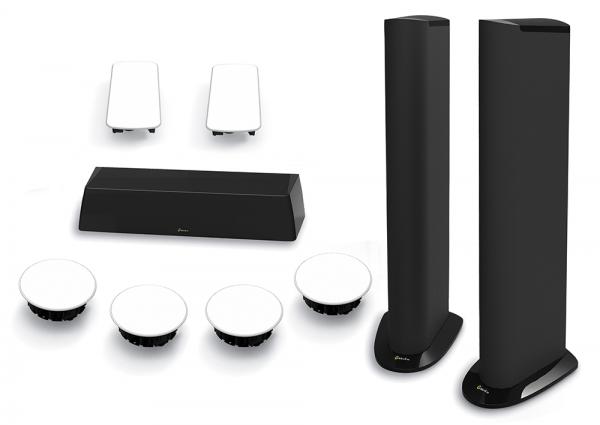
With the hindsight of four years of product development, GoldenEar reboots their very first speaker with updated drivers, crossover, and low-frequency DSP—to quite stellar results.
Specs
Triton Two+: 5 x 9 in glass fiber/Nomex composite cone woofer (2), 7 x 10 in MDF passive radiator (2), 4.5 in polypropylene cone midrange (2), 1 in folded planar magnetic tweeter; 5.25 (front)/7.5 (rear) x 48 x 15 in (WxHxD); 60 lb
SuperCenter XXL: 5.25 in polypropylene woofer (4), 6.75 x 8 in MDF passive radiator (2), 7 x 10 in MDF passive radiator, 1 in folded planar magnetic tweeter; 35 x 5.75 x 11 in (WxHxD); 31 lb
Invisa HTR 7000: 7 in polypropylene cone woofer, 1 in folded planar magnetic tweeter; 10 x 10 x 5 in (WxHxD); 4.5 lb
Invisa MPX: 4.5 in polypropylene cone woofer (2), 1 in folded planar magnetic tweeter; 7.25 x 13.9 x 3.75 in (WxHxD); 6 lb
Price: $7,750 (Triton Two+, $1,750 ea; SuperCenter XXL, $1,250; Invisa HTR 7000, $500 ea; Invisa MPX, $500 ea)
Unfortunately, the first GoldenEar Technology Triton Two loudspeaker I ever saw didn’t work. It wasn’t the result of shoddy workmanship, chintzy materials, or some brutal, shipping-induced internal hemorrhage of crossovers and cables. Truth be told, the speaker wasn’t technically a Triton Two because, at the time (in early January during CES 2010), GoldenEar Technology didn’t officially exist. The tall, dark tower standing silently in front of me was a cosmetic mock-up of what would become the Triton Two— GoldenEar’s first speaker. In other words, this mute monolith, wrapped in black fabric, was merely a hollow shell of its future towerful self.
I won’t spend much time retelling GoldenEar’s back story. If you’re interested in learning the impressive pedigree, see my review of the Triton One (Sound & Vision, June 2014 and soundandvision.com). The SparkNotes version goes like this, beginning in 1972: Sandy Gross co-founded Polk Audio and then Definitive Technology, the latter in partnership with quiet Canadian engineer extraordinaire Don Givogue. Gross and Givogue emerged from semi-retirement in 2010 (word is that Givogue was “slightly” reluctant and had to be dragged off his fishing boat) to start GoldenEar. This time around, Gross told me then, he wanted to design loudspeakers that sounded like the $10,000-plus pair of electrostatics he had in his listening room at home— but speakers that would be easier to live with and, most important, cost a lot less.
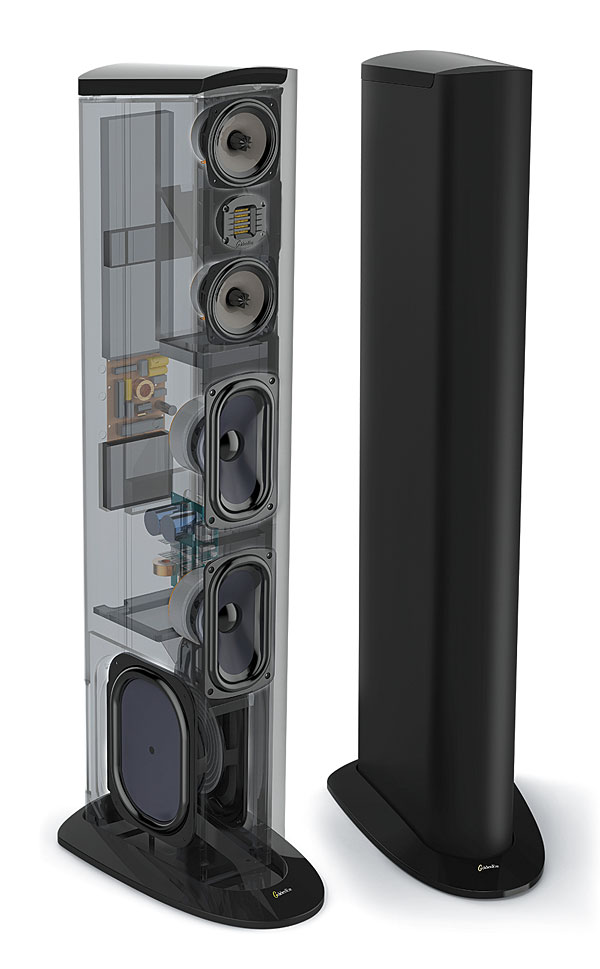
The Optimist’s Primes
After five years, the prime-numbered Triton speaker range includes, in order of creation, the Two, Three, Seven, Five, and ultimately, even though by definition not a prime number though integral to defining a prime number, the One. The Triton One is a truly amazing-sounding loudspeaker. But the fact that a pair of Ones will set you back only $5,000 is stunning. So many glowing reviews of the speaker have been published that I’ve heard the Oxford English Dictionary is planning to define “Triton One” as “so astoundingly awesome, you should bring along an extra pair of underwear.” (Or something like that.) There may also be a Triton One emoji coming soon.
Gross and Givogue don’t sit around all day building prototype speakers in their parents’ garages. GoldenEar has an engineering facility in Arnprior, Ontario, Canada. There, Bob Johnston and a team of engineers have enviable access to the company’s own full-size anechoic chamber, which Gross says is a “duplicate of the world-famous chamber at the NRC [National Research Council of Canada].” GoldenEar’s chamber is so serious that it’s “fully suspended from its environment, so that the delicate measurements taken within it are not interfered with by outside disturbances and vibrations such as beer bottles being opened or hockey pucks hitting the outside.” Actually, the beer and hockey references were added by me, not Gross. The point is that the chamber allows GoldenEar to measure subtleties and refine a speaker’s performance in a manner that’s potentially more revealing than other methods would be.
Although the anechoic chamber isn’t new, Gross says that since initially designing the Triton Two and Three speakers, GoldenEar acquired new development software, “including a unique program for cones and surrounds.” (He means the surrounds that encircle the outer edges of cone drivers—not surround speakers.) In other words, GoldenEar’s golden ears learned quite a bit along the Via Triton that culminated in the One.
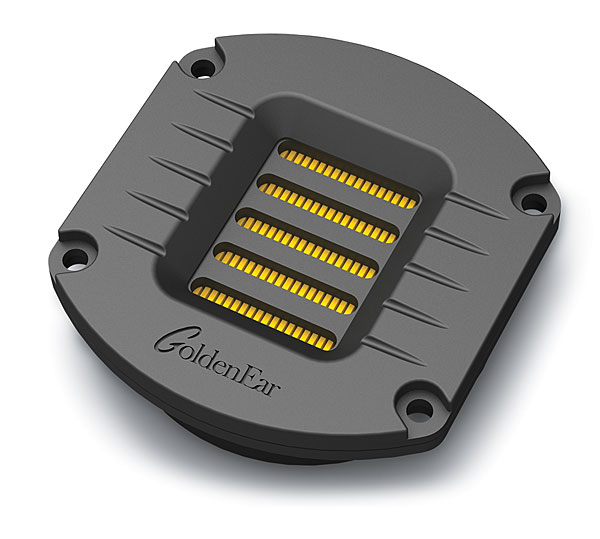
That left the original and early Triton Two feeling severely outdated. Gross wanted to produce a reality TV show, called Rehab My Speaker (the working title was Crossover This!), but he couldn’t get HGTV to run it. Instead, after binge-watching several seasons of The Six Million Dollar Man from the 1970s, Gross decided that the GoldenEar team should do their own upgrading of the Triton Two. Wisely realizing that no one would buy a Triton Two+ for six million dollars (GoldenEar speakers may be good, but they ain’t that good), the engineers didn’t add sophisticated robotic legs or computerized telescopic eyes—but the changes they did make were certainly noticeable.
Old Highs with New Lows
From the outside, the Triton Two+ looks virtually identical to the original Triton Two (the non-plus—but definitely not nonplussed—version). It has the same black cloth fabric over a columnar grille in the front, with a gloss black plinth and matching cap. The only difference is that the amplifier power-status LED is now a relatively bright blue, rather than the more subtle green. It’s bright enough that, in a very dark room, you might notice a radioactive-looking blue glow spilling along the floor behind the speaker. If it bugs you or breaks your mood, you can always put a piece of black electrical tape over it.
Behind the grille, the Two+ inherits the same High Velocity Folded Ribbon (HVFR) tweeter found in the Two and all the other Triton speakers. As we’ve frequently pointed out, this is technically a magnetic planar tweeter design that utilizes a flat diaphragm that has been pleated, like the sides of a squeeze-box (or accordion, for highfalutin people), and it creates sound by rapidly squeezing and stretching the pleats to compress and rarefy air. This proprietary tweeter plays a huge role in giving all the GoldenEar speakers their characteristic sound.
Brand new, however, are the two 4.5-inch midrange drivers mounted above and below the HVFR tweeter in a D’Appolito arrangement. They’re a huge beneficiary of Triton One hand-me-down technology, as they were re-engineered with a new cone, surround, spider, and voice coil. GoldenEar also developed a completely new balanced crossover incorporating polypropylene capacitors, one that is very similar to the crossover in the Triton One. The DSP-based low-frequency control unit for the amplified bass section has been reprogrammed, too. Gross was emphatic about getting the crossover design right. In fact, just like the cardinals at the Vatican when electing a new Pope, the engineers were locked in a room and required to try out all sorts of “subtle variations of crossover and DSP tuning in order to get the voicing exactly right.”
As as a result of the upgrades, Gross says the Triton Two+ benefits from “a significantly smoother, higher-resolution, more open, more revealing, and more highly detailed sound. In addition, there is dramatically more expansive imaging and tighter, faster, and better-integrated bass.”
The Big and Tall Man’s Center
We wanted to take the opportunity presented by the arrival of the Triton Two+ to listen to a few other GoldenEar models we’ve not yet heard, so we set up a Dolby Atmos 5.0.4 system that also included the new SuperCenter XXL center-channel speaker along with a pair of Invisa MPX in-walls for surrounds plus two pair of Invisa HTR 7000 in-ceiling speakers for the front and rear height channels. The middle zero in the Atmos configuration numbering isn’t a typo. Not only did GoldenEar not send a dedicated subwoofer, but—as per Gross’s usual recommendation—I also set the front speaker parameter to Large and ran only speaker wires to the Triton Two+ towers. In other words, neither the subwoofer output of the AVR nor LFE input on the Two+ was used. All deep bass was provided by the Tritons with their powered bass sections and built-in crossovers.
The appropriately named SuperCenter XXL is a monster, measuring 35 inches wide x 5.75 inches high x 11 inches deep. Inside the familiar black-fabric-sock grille cloth is a two-and-a-half-way design utilizing a three-chambered cabinet. The central chamber holds one HVFR tweeter plus two 5.25-inch woofers that are coupled to a 7 x 10-inch top-firing passive radiator. Two smaller chambers sandwich the central section, and each contains its own 5.25-inch bass driver (crossed over at a lower frequency than the 5.25-inch drivers used in the middle) coupled to a dedicated 6.75 x 8-inch passive radiator, which is also top-firing.
The architectural speakers from GoldenEar aren’t new. The round Invisa HTR 7000 is the company’s flagship in-ceiling model, using a 7-inch bass driver (the same one that’s in GoldenEar’s Aon 3 monitor speaker) and a smaller version of the HVFR tweeter. The driver assembly is angled so the dispersion pattern can be aimed in the direction of the listener, which makes the HTR 7000 especially applicable for systems using in-ceiling speakers for the front LCR channels. The rectangular Invisa MPX is what GoldenEar calls a “MultiPolar” architectural speaker because it uses a design that attempts to mind-meld a direct-radiating speaker with a bipolar speaker. In addition to the forward-firing HVFR tweeter (the smaller one), there’s a pair of 4.5-inch bass drivers—one above and one below the tweeter—angled out sideways of the tweeter, in as much of an approximation of opposite directions as can be expected from a flush in-wall speaker.
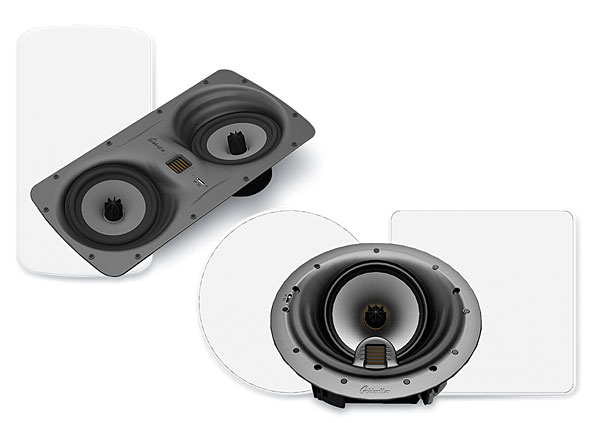
Virtually Reality
Four years is a long time between evaluations—too long to establish a solid frame of reference between the old Triton Two and the new Triton Two+ short of having both in the same room. But I did revisit much of the same demo material I used to review the then brand-new Triton Two in 2011. I’ve heard these music selections countless times on other speakers, but after I listened to them on the Triton Two+ towers, my initial reaction was: “Holy crap!” The soundstage on Roger Waters’ “The Ballad of Bill Hubbard” was as broad as, if not broader than, what I’ve heard with any other speaker pair. What struck me was a slightly forward presentation of Jeff Beck’s guitar in this track. I really noticed this on two pieces I listened to that feature a solo vocal with an acoustic guitar: Lyle Lovett’s “Promises” and Mary Chapin Carpenter’s “Dead Man Walking (A Dream Like This),” both from the tie-in CD to the film Dead Man Walking. In each case, it wasn’t that the vocal was inappropriately shifted forward. Rather, it seemed a tad more defined and distinct in the midst of the music without being distractingly (and annoyingly) in your face. The vocal was fully present without being overly dominant. The new Triton Two+ definitely nudges closer to what I recall as the sound of the Triton One I reviewed last year.
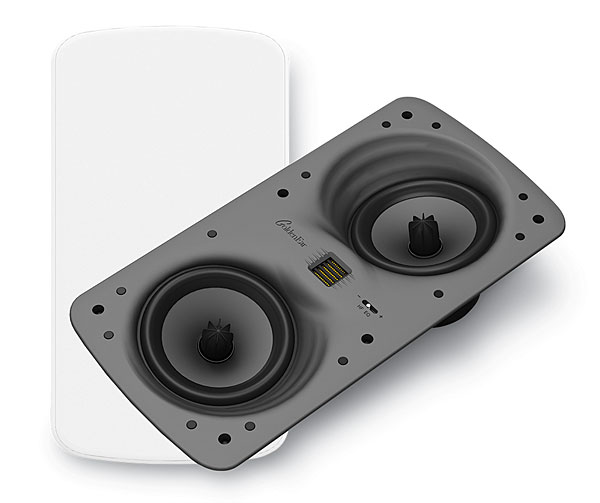
The care in executing the new DSP and the updated bass tuning were just as evident. Listening to “Tribute” from Ross William Perry’s It’ll All Make Sense demonstrated the claimed “tighter, faster, and better-integrated bass.” The output of the bass and midrange drivers are so closely woven together that it’s hard to believe it’s all coming from a variety of separate drivers and passive radiators. The three-dimensional playback of Dirk Sengotta’s “Drum Solo” from the Henrik Frieschlader Band’s Live disc was so arresting that it bordered on disorienting, with clear placement of each piece in the drum kit and every tap on a cymbal. If you could make a hologram out of sound, this would be it. For music listening, the Triton Two+ proved itself a truly captivating, sublime, and thoroughly engaging speaker.
Zero to Ten
With the Triton Two+ speakers anchoring the Dolby Atmos 5.0.4 configuration, it was no surprise that the bass output of the full theater system was sensational. As you’d expect, Terminator Genisys isn’t a quiet movie. With the GoldenEar system, each time a time machine was activated (spoiler alert: there’s a time machine in this movie), it was time for a low-frequency thrill ride. Of course, never having been near an actual time machine, I can’t say for sure how detailed and accurate the GoldenEars were. But I’m pretty sure that if there really were a time machine—which there isn’t because if there were, I’d have gone back and deleted this sentence—it would sound like what I heard with this system. In one scene, a bunker full of explosives undergoes some serious renovation, and the resulting shock wave was so impressively stable and full that I’m not sure there’s another powered tower speaker (perhaps short of a Triton One) that could match it.
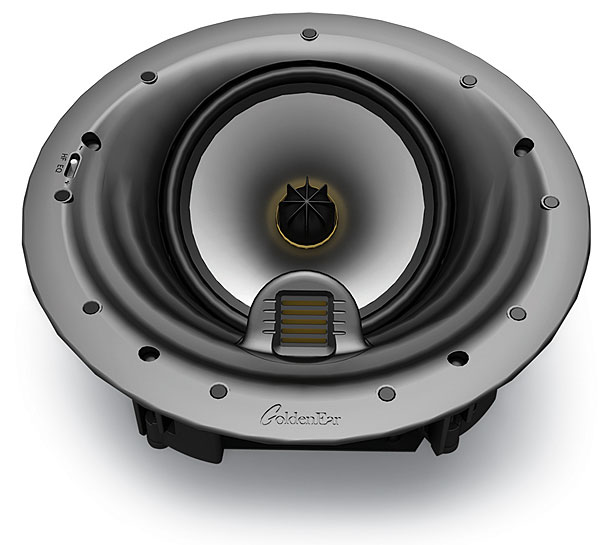
Mad Max: Fury Road isn’t a quiet movie, either. In this depiction of a nightmarish automotive future, the omnipresent rumble of particulate-spewing, flame-belching engines is an integral aspect of the story. A lesser system would no doubt leave you feeling cheated because your brain would be searching for what your ears weren’t hearing. But the Titan Two+ towers didn’t just rumble at lower and lower frequencies—the bass section was as detailed and nuanced as it was visceral and impactful.
Hearing Voices
If the rugged, intense bass were all these movies had going for them, well, then they’d still be popular. Fortunately for us, the Dolby Atmos soundtracks of both movies are spectacular 3D acoustic playgrounds that are remarkable examples of how good the new technology can be. I’m sure that the opening of Mad Max: Fury Road will soon become a de rigueur Atmos demo clip because the haunting voices from Max’s past come and go from all directions throughout the room. This scene was a great test of the close match between the SuperCenter XXL and the Triton Two+ towers—and especially of the beautifully smooth soundspace created by the Invisa HTR 7000s and Invisa MPXs.
Terminator Genisys has plenty of its own remarkable Atmos moments. In the opening scene, a young boy hides in a drainage tunnel because he’s afraid that something is coming his way; on the GoldenEar system, the sounds of a dog barking and the footsteps that echo off the curved enclosure were beautifully rendered. Here all the models sounded like one coherent unit instead of separate speakers that happened to have been thrown together.
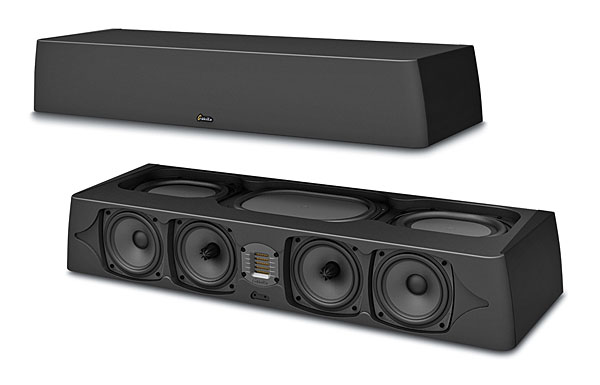
Speaking of performing as one, I was thrilled to hear the way the SuperCenter XXL was able to match the outstanding performance of the Triton Two+ pair. There’s a scene in Terminator Genisys, for example, where Sarah and Kyle are undressing on opposite sides of a row of gym lockers. As the camera pans back and forth, their voices move across the front of the room accordingly. To say that it didn’t even seem as if the SuperCenter XXL was present in the system is a tremendous compliment. The speaker never drew attention to itself, either by overemphasizing or underperforming.
Conclusion
GoldenEar Technology has quoted many reviewers (including yours truly) commenting that GoldenEar speakers sound as good as or better than speakers costing three times (or whatever) as much—a comment that justifiably annoys some people, who ask, “Really? Which ones?” That’s a difficult question to answer because there are so many factors that go into the value of a speaker, more than just sound and price, including cosmetic design, cabinet finish, size, placement requirements, application, power requirements, subwoofer or no subwoofer, etc. That’s not a cop-out. It’s simply a fact. I think the problem is that (in my case, anyway) I’ve been lazy and have taken the easy way of trying to convey my feelings about the value of GoldenEar speakers. What I should have said then—and what I emphatically say now about the Triton Two+ speakers—is that the sound quality is so good that GoldenEar’s speakers would still be highly recommended even if they cost three times as much. The fact that they don’t is one more reason why they are so damn impressive.
Sony’s VPL-VW350ES 4K Projector
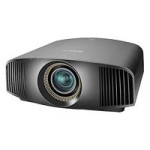 As we are approaching the holiday gift-giving season, now is the time to look for top-notch electronic equipment for your home theater. The Sony VPL-VW350ES projector is known for delivering high quality images that are more detailed than other projectors in its price range. While pricing is still on the upper end of most electronic audio and visual equipment, the VPL-VW350ES projector finally fulfills the promise of 4K resolution.
As we are approaching the holiday gift-giving season, now is the time to look for top-notch electronic equipment for your home theater. The Sony VPL-VW350ES projector is known for delivering high quality images that are more detailed than other projectors in its price range. While pricing is still on the upper end of most electronic audio and visual equipment, the VPL-VW350ES projector finally fulfills the promise of 4K resolution.
The VPL-VW350ES is rectangle in shape with rounded edges at the top and a delicate bow in the front and the rear. The coarse-textured, predominantly charcoal gray matte finish will blend in well with any home theater ceiling. The charcoal gray coloring is complemented by the lens which is a glossy black.
This large projector weighs 31 pounds; the dimensions are measured at 18.25” wide by 7.7” high with a depth of 19.5”. The inputs and controls are inconspicuously placed on the bottom left and right sides of the projector, while the vents border the lens in front to keep the equipment cool. While the VPL-VW350ES projector is in use, it is almost completely silent, even when the “High” cooling mode is used. Fan noise is not a problem with this particular projector.
The Sony clicker is very simple to use. There are specific keys dedicated to nine picture modes and shortcuts have been developed for a number of the most frequently used adjustments. Every key is completely backlit for easy use.
Setting up the VPL-VW350ES projector is easy as well, thanks to the motorized power zoom, lens shift and sharp focus, not to mention the independently adjustable legs on each corner. The substantial lens shift can adjust to any installation, even those that are more complicated, without needing intricate extended mounting equipment.
The Sony VPL-VW350ES 4K projector provides marvelous picture quality overall with accurate color and great shadow detail. It delivers best-in-class picture viewing with extra resolution for certain 4K sources. 4K content includes movies, including content from 4K Blu-ray players/discs, and high resolution photos. Sony has stated that they are fully committed to supporting 4K content, including cable, satellite and on-air formats, in the future.
This Sony projector claims 1500 lumens. Light outputs and black levels work well and the exceptional video processing helps to deliver a great viewing experience for all. In addition, the VPL-VW350ES projector does support the full HD 3D standard, but it is 1080p only (standards for 4K 3D have not yet been developed.) The RF transmitter is built into the projector, however 3D glasses are not included. Both Sony and third party glasses work well, but must be purchased separately.
This projector includes two HDMI inputs that are capable of handling 4K input resolutions at 60 frames/second. In addition, the projector also includes a USB port for updating software, a control only Ethernet/Lan port, an IR remote port, an RS-232 serial remote port and two remote triggers.
If you are planning to build a home theater in your home or if you are looking to upgrade your home theater viewing experience, consider adding a Sony VPL-VW350ES 4K projector to your Christmas wish list!
Integra’s DTR-40.7 Receiver
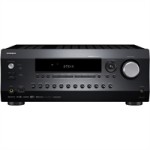 Integra has recently released several new 7.2 channel network receivers, including the DTR-40.7 7.2 model. This particular 7.2 channel receiver is DTS:X compatible, allowing owners to enable the latest in exceptional audio experiences. One could say that the DTS:X brings audio to a new level of sound interaction and immersion.
Integra has recently released several new 7.2 channel network receivers, including the DTR-40.7 7.2 model. This particular 7.2 channel receiver is DTS:X compatible, allowing owners to enable the latest in exceptional audio experiences. One could say that the DTS:X brings audio to a new level of sound interaction and immersion.
With a DTS:X receiver, sound is located where listeners naturally expect it to be, producing an incredibly realistic and multi-dimensional sound experience. Since there are no channel restrictions, sound can be moved to the exact place you would hear it in the real world, making for much more engaging and personalized home entertainment.
Unlike many receivers, DS:X does not call for a specific speaker arrangement. Speakers can be incorporated into any home theater system design. For the best immersive sound experience, Integra does recommend that height is incorporated into any personalized speaker layout. Because the DTS-X technology allows for customization that enhances the entire audio experience, home theater owners will find that action movies are more intense and horror movies are even scarier with the Integra DTR-40.7 receiver.
This new Integra 7.2 channel network receiver also features Dolby Atmos decoding that will fill your home theater with rich sounds. It will turn ordinary audio experiences into amazing sounds that bring whatever you are watching to life. Movies, music and video games will come alive with sound details that make listeners believe they are right there in the actual scene or at a concert.
The new DTR-40.7 receiver is THX Select2 Plus certified and it includes the technology that permits the broadcasting of HDMI audio/video signals over greater distances with an easy to install cable. No HDMI connection is necessary. This receiver is designed for sound distribution throughout the home; with just one CAT5e/6 cable, the DTR-40.7 can be connected to any compatible electronic device available. Custom integration specialists love this receiver because it can cross greater distances with uncompressed 3D and 4K Ultra HD multimedia.
For Ultra HD entertainment, this particular model contains 4K/60 Hz-capable HDMI terminals. There are 8 inputs (1 in the front / 7 in the back) and 2 outputs (4 K Ultra HD / HDCP 2.2). The receiver also features 175 watts/channel at 6 Ohms and 110 watts/channel at 8 Ohms, along with a first-rate 384 kHz / 32-bit hi-grade AKM 4458 DAC that opens up the full capabilities of the many audio features.
The DTR-40.7 also includes Zone 2 capabilities and the quality of the digital-to-analog conversion is great. Not only are internal digital sources available, including Spotify, Pandora, and Sirius/XM, when connected using Coax and Toslink (2-ch PCM only), external sources are accessible in Zone 2 as well. Sharing favorite family tunes throughout the house couldn’t be easier. With the included Integra Remote, family members can fully control the Zone 2 functions from anywhere in the house.
If you prefer a customized home theater system and want the highest quality audio, Integra’s DTR-40.7 7.2 channel network receiver could be a perfect addition for extraordinary home entertainment. If you enjoy a great symphony or want your favorite movie to feel like a real-life experience, this is a receiver that you and your family will enjoy!
JVC’s Diamond Series DM65USR TV
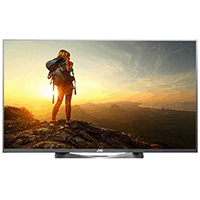 Ultra HD TV’s are starting to become popular in the electronics world, with new UHD products entering the market regularly. JVC entered the market with a bang when they introduced the Diamond Series DM65USR. This 65-inch UHD model has a number of great features, including CrystalMotion Pro 240 technology to decrease motion blur and a full-array LED backlight that includes local dimming. Built-in WiFi is included, along with a Roku Stick to use for a variety of streaming services.
Ultra HD TV’s are starting to become popular in the electronics world, with new UHD products entering the market regularly. JVC entered the market with a bang when they introduced the Diamond Series DM65USR. This 65-inch UHD model has a number of great features, including CrystalMotion Pro 240 technology to decrease motion blur and a full-array LED backlight that includes local dimming. Built-in WiFi is included, along with a Roku Stick to use for a variety of streaming services.
While many TVs are traditionally black, the DM65USR is a sleek brushed silver color that will look nice in any home theater or living room. This 65-inch TV sits on a triangular, non-swiveling stand that has the same silver coloring.
The DM65USR comes with a dual-sided remote. The front has the regular TV button design, while the back has a touch pad control and a regular QWERTY keyboard. The controls on the back panel are activated when the remote is flipped from the front to the back side. Once the remote is synced up with the TV, several commands like home and menu will work without line of sight to the TV.
This TV’s connection panel includes five HDMI inputs; four of the inputs will support HDMI 2.0, along with the HDCP copy protection for compatibility with the future high resolution Ultra HD Blu-ray format. The remaining HDMI input allows users to connect and power up the Roku Stick that is included. The connection panel also includes several other necessary inputs and outputs, as well as two USB ports and a LAN port.
The DM65USR includes six different pictures modes: standard, movie, sports, game, vivid and custom. To further adjust your picture setting, there are several more advanced adjustments available, including an ambient light sensor to adjust the brightness based on the room environment, a multi-step adjustable backlight and white balance controls to adjust the color temperature, if necessary. Other advanced adjustments are included, such as noise reduction and a color management system. The CrystalMotion Pro 240, which reduces blur, has several different options to use, depending on your preferences.
From an audio perspective, DM65USR’s speakers are dynamic and produce a full rich sound that is better than most flat-panel sound systems. Set-up is fairly easy with controls for treble, bass and balance, along with EQadjustment and lip sync controls. XinemaSound 3D gives the ability to use specialized sound modes and the XinemaSound Leveler allows users to reduce annoying volume inconsistencies between sources.
This JVC TV has smart TV functionality with the Roku Stick and a Roku account. By plugging the Roku Stick into the HDMI/MHL port, you can access all the Roku services that are currently available. The Roku stick is an excellent smart TV solution with an easy-to-use interface and a great collection of apps to use.
If you are looking for a TV with great picture quality, you will certainly like this Diamond Series DM65USR. Using the full-LED backlight dimming feature, you will enjoy a fine dark-room performance. For sports or daytime viewing, you will find that the DM65USR offers great light output as well. You and your family will appreciate this TV and all that it has to offer!
Polk MagniFi Soundbar – Rich Bass Audio
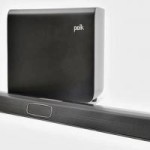 When looking for speakers for a home theater center, most people immediately think that bigger is better. As with many things, however, looks can be misleading. Take the Polk MagniFi Soundbar system, for example. While this reasonably priced soundbar is compact in size, its sound capabilities will be a hit when it comes to watching your favorite TV show or your family’s movie nights.
When looking for speakers for a home theater center, most people immediately think that bigger is better. As with many things, however, looks can be misleading. Take the Polk MagniFi Soundbar system, for example. While this reasonably priced soundbar is compact in size, its sound capabilities will be a hit when it comes to watching your favorite TV show or your family’s movie nights.
The MagniFi soundbar has a very low profile (38x3x2 inches) as compared to other soundbars on the market. It easily fits beneath a TV screen and therefore seldom blocks remote control signals. This particular soundbar includes a center, right and left driver. The controls (Power, Bass, Volume and Voice) are located on top of the case. There is also a Bluetooth control button if you are looking for a wireless connection. Unlike some soundbars that include an HDMI connection, the MagniFi Soundbar comes with one optical digital port and a 3.5m analog port. The Polk MagniFi Soundbar system also includes a wireless 13x12x9 inch subwoofer and a 7 inch woofer that is not big enough to feel intrusive, yet it definitely enhances the overall sound quality.
The MagniFi Soundbar easily connects to a TV using an optical digital audio cable. The soundbar and the subwoofer come paired together, therefore they are synced immediately when they are turned on. If necessary, however, they can be manually synced by pressing the buttons on the back of each piece of equipment.
As everyone’s tastes are different, you can manually adjust the voice and bass to find the best combination for your home theater space. Many folks choose to increase the center channel to balance the deep, rich bass. You can also modify the sound by choosing one of the two sound modes – music or movie. The movie mode seems to produce a more pronounced dialog through the center channel.
The Polk MagniFi Soundbar system features a great sound that will fill a room and it surpasses expectations when listening to movie/TV action scenes or any kind of dialogue. When listening to music, the subwoofer provides a deep, rich sound, however the treble sometimes falls short of expectations. When listening to your favorite songs, you will find that the music setting sounds better than the movie setting.
The bottom line is this: the Polk MagniFi Soundbar easily fills a room with tons of bass sound and clear, easy to understand dialogue, even though with its unobtrusive size, it doesn’t seem large enough to do so. As it pairs up with the subwoofer, it ensures complete immersion for those watching a great movie or TV show. While this soundbar system offers few extra frills, it will certainly guarantee a pleasurable sound experience with your family’s home theater system.
More...



Connect With All Star